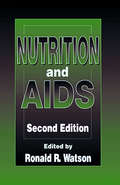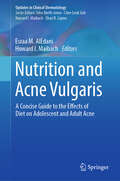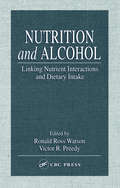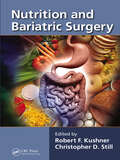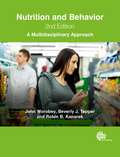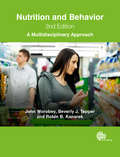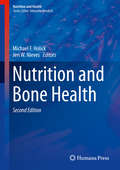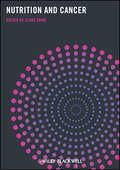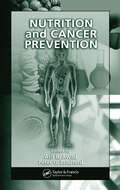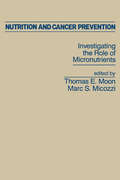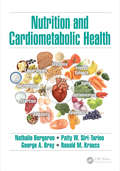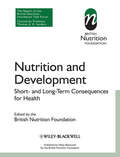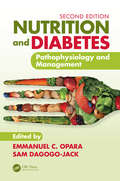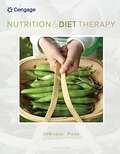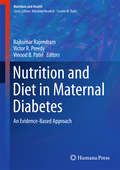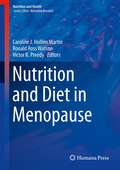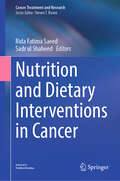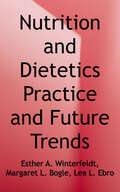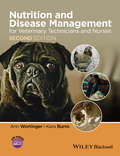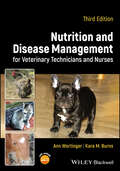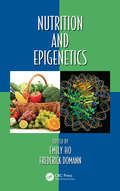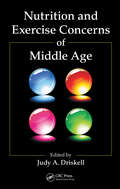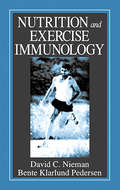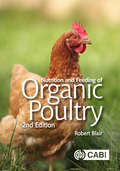- Table View
- List View
Nutrition and AIDS (Modern Nutrition)
by Ronald R. WatsonEvidence shows that nutritional supports can help maintain health in the HIV-infected patient by replacing lost nutrients, compensating for nutritional damage done by the retrovirus-induced immunodeficiency, and stimulating the remaining immune system and cells for better host defenses.This new edition of Nutrition and AIDS is a timely look
Nutrition and Acne Vulgaris: A Concise Guide to the Effects of Diet on Adolescent and Adult Acne (Updates in Clinical Dermatology)
by Howard I. Maibach Esraa M. AlEdaniThis book is an authoritative and comprehensive volume that is dedicated to the role of diet and the effect of nutrition on adolescent and adult acne. This book provides up to date information and synopsis about the mechanism of diet and how it leads to acne formation and inflammation. Chapters address the effectiveness of nutrition on acne vulgaris, and the role of each diet component and its mechanism on acne exacerbation and inflammation. For example, how specific diet like dairy products increase acne formation while others like vegans and leafy greens mitigate acne formation. The last chapter of this book discuss other minor nutritional triggers that affect acne, or other triggers like environmental, bad habits, bad hygiene etc. Nutrition and Acne Vulgaris - A Concise Guide to the Effects of Diet on Adolescent and Adult Acne is a valuable resource for dermatologists and allied healthcare individuals.
Nutrition and Alcohol: Linking Nutrient Interactions and Dietary Intake
by Victor R. Preedy Ronald Ross WatsonOver the past decade, much has been learned about the damaging effects that moderate to severe alcohol use has on tissue nutrient levels and dietary intake. In addition to alcohol's potential to damage every organ in the body, alcohol abuse or heavy use causes poorer dietary intake and provides a greater risk of alcohol's damage while increasing th
Nutrition and Bariatric Surgery
by Robert F. Kushner Christopher D. StillBariatric surgery has led to improved health outcomes including significant weight loss and reduction in co-morbidities among patients with obesity. Clinical practice guidelines recommend that patients considering bariatric surgery undergo a comprehensive nutritional assessment. Nutrition and Bariatric Surgery is the first comprehensive book that u
Nutrition and Behavior
by John Worobey Beverly Tepper Robin KanarekDespite their widespread coverage in the media, there is little emphasis on nutrition in books in psychology, and most textbooks in nutrition barely acknowledge the behavioral correlates of nutrient status. This book will provide interested readers in the fields of nutrition and psychology with information on how these two areas of current research interface. Traditional topics (e.g., micronutrients, sugar, eating disorders) are addressed, as well as the newest topics (e.g., herbs, PUFAs, obesity). Critically reviewed are research methods and results that demonstrate the utility of considering both perspectives when designing studies to explore human behavior.
Nutrition and Behavior: A Multidisciplinary Approach
by John Worobey Beverly Tepper Robin B KanarekThe relationship between nutrition and behaviour is bi-directional in nature, with nutritional factors able to affect activity and disposition, and behavior impacting diet and food intake. This book reviews these links, starting with their complex neurobiological basis, such as in the case of folate deficiency and cognitive decline. It also illustrates how behaviour may determine nutritional choices or status through peer modelling and poor dietary habits. Micronutrients and eating disorders are then critically addressed, with a review of current research methods and results, before extra-nutritional influencers on behaviour such as caffeine, herbal supplements and alcohol are discussed in the final section.
Nutrition and Bone Health
by Michael F. Holick Jeri W. NievesThis newly revised edition contains updated versions of all of the topics that were in the first edition and has been substantially expanded with an additional 5 chapters. Each chapter includes information from the most up-to-date research on how nutritional factors can affect bone health, written with an evidence-based focus and complete with comprehensive references for each subject. Nutrition and Bone Health, second edition covers all aspects of nutrition and the skeleton, from the history and fundamentals, to the effects of macronutrients, minerals, vitamins, and supplements, and even covers the effects of lifestyle, the different life stages, and nutrition-related disorders and secondary osteoporosis. New chapters include HIV & AIDs and the skeleton, celiac disease and bone health, and nutrition and bone health in space. Nutrition and Bone Health, second edition is a necessary resource for health care professionals, medical students, graduate students, dietitians, and nutritionists who are interested in how nutrition affects bone health during all stages of life.
Nutrition and Cancer
by Clare ShawNutrition plays a crucial role in supporting patients receiving treatment for cancer. Carefully considered nutritional options can help to manage patients with weight loss and cachexia, support the patient’s ability to recover from surgery and cope with treatments such as chemotherapy and radiotherapy. Patients living with and beyond cancer can also benefit from advice on optimal nutrition and lifestyle changes. Edited by Dr Clare Shaw, Consultant Dietitian at The Royal Marsden NHS Foundation Trust, Nutrition and Cancer takes an unrivalled look at this prevalent disease, offering the reader: An insight into the nutritional challenges faced for patients with cancer A practical guide to nutrition and dietetic practice in cancer care A detailed look at nutritional options for different diagnostic groups Contributions from a wide range of cancer specialists An excellent resource for dietitians, clinical nutritionists, doctors, nurses and other health professionals working with cancer patients, this book is also a fascinating reference for students and researchers with an interest in the area.
Nutrition and Cancer Prevention
by Atif B. Awad Peter G. Bradford� Epidemiological studies have estimated that approximately 35 percent of cancers are potentially avoidable by nutritional modification. These modifications include strategies such as caloric restriction and limitation of specific macro-nutrient groups. However, recent research indicates that what you eat may well be just as important as what you s
Nutrition and Cancer Prevention
by Thomas E. Moon; Marc S. MicozziScientific advances have led to the recognition that many chronic diseases such as cancer may be preventable. In this volume, 36 contributions test cancer prevention hypotheses, attempt to interpret their results, and provide a guide to the background, rationale, and selection of cancer prevention agents, as well as the design, im>plementation, and evaluation of cancer prevention studies. It will offer assistance to many in the conduct of investigations and will be of interest to all in the in>terpretation of research results in the scientific literature.
Nutrition and Cardiometabolic Health
by George A. Bray Nathalie Bergeron Patty W. Siri-Tarino Ronald M. KraussNutrition plays a key role in prevention of cardiovascular disease, the leading cause of death worldwide. Diet influences a broad spectrum of cardiometabolic risk factors, notably a cluster including excess adiposity, dyslipidemia, impaired glucose metabolism and high blood pressure. In the face of the rapidly increasing incidence of obesity and diabetes, maintaining cardiometabolic health through adoption of a healthy lifestyle is a top public health priority. <P><P>In this book, Nutrition and Cardiometabolic Health, international experts present state-of-the-art scholarly reviews of dietary and lifestyle effects on metabolic systems associated with cardiovascular health and disease. It covers a broad range of topics including biological and behavioral processes regulating food intake; lifestyle and surgical approaches to weight loss; nutritional considerations for optimal cardiometabolic health across the lifespan; the relationship of macronutrients, whole foods and dietary patterns to diabetes and cardiovascular disease; and diet as a modulator of gene expression, epigenetics and the gut microbiome and the relationship of these traits to disorders of metabolism. This book provides its readers with an authoritative view of the present state of knowledge of dietary effects on cardiometabolic health and will be of interest to nutrition and healthcare professionals alike.
Nutrition and Development
by BnfThis Task Force report reviews the evidence that the seeds of many adult diseases are sown in utero and in infancy. The report, written by experts in the field, summarises current knowledge in this area. It illustrates how early life nutrition can bring about changes in organ development and function, thus programming risk of disease in adult life. It also considers what might be done in early life to reduce the burden of future ill health.Nutrition and Development: Short- and Long-Term Consequences for Health includes chapters on the history of this topic area, normal growth and development, and current recommendations and practice in relation to nutrition and diet in early life. Chapters exploring the possible mechanisms and pathways of critical windows for development cover the effects of diet and nutrition in early life on organ and skeletal development, the role of sex hormones in programming disease susceptibility, the establishment of gastrointestinal microbiota, and the impact of early life nutrition on cognitive and neurological development. This new report:* describes how development occurs and explores how changes in the fetal and postnatal environment, such as over- or under-nutrition, can result in permanent alterations in function; * explains how diet and nutrition in early life can affect risk of adult disease, with specific chapters on allergic disease and asthma, bone health, cancer, cardiovascular disease, cognitive function, diabetes and obesity; * includes a summary of the key points, as well as recommendations in each chapter to help fill the gaps in our knowledge; * provides an overview of the main messages in a practical question and answer format suitable for lay readers.Nutrition and Development is an important information resource for those involved in research and teaching in the health sciences sector and is also of value to those involved in making decisions about health policy. It will be of interest to a broad range of health professionals, the food industry and those who write and broadcast about the effects of food on health.
Nutrition and Diabetes: Pathophysiology and Management
by Emmanuel C. Opara and Sam Dagogo-JackDiabetes occurs at such an alarming rate that it can be described as a global epidemic. Following its predecessor, Nutrition and Diabetes: Pathophysiology and Management, Second Edition, is a comprehensive resource that describes various factors that drive the accumulation of excess body weight and fat resulting in obesity. The book discusses the metabolic aberrations found in obesity and how they lead to the association of obesity with diabetes. This new edition highlights the role played by diet and the interrelationships in the metabolism of key nutrients in the pathogenesis of obesity and diabetes which provides the scientific basis for treatment and management approaches.Features Highlights the role of nutrition in the pathogenesis of obesity and diabetes Organized logically into two easy-to-use sections - Pathophysiology and Management of Obesity and Pathophysiology and Treatment of Diabetes Features emerging therapeutic approaches for management of obesity and diabetes Discusses experience in the management of obesity and diabetes in developing countries Presents challenges in insulin therapy and provides guidelines to overcome them The first section of the book retains key topics from the previous edition and contains new chapters including genetic determinants of nutrient processing; fat distribution and diabetes mellitus; combined effect of diet and physical activity in the management of obesity; pharmacologic treatment of obesity; and the role of gut microbiota in the pathogenesis and treatment of obesity. The second section features updated versions of most of the other chapters in the first edition comprising a modified chapter on oxidative stress and the effects of dietary supplements on glycemic control in Type 2 diabetes. In addition, new chapters are added in this section and include the contribution of iron and transition metal micronutrients to diabetes; role of microbiota in the pathogenesis and treatment of diabetes; primary prevention of Type 2 diabetes; and the pathophysiology and management of Type 1 diabetes.
Nutrition and Diet Therapy (Mindtap Course List Series)
by Kathryn Pinna Linda Kelly DeBruyneSet audacious nutritional goals with NUTRITION AND DIET THERAPY, 10th Edition! The core nutrition concepts and the latest clinical approaches in this book set you up for success, no matter your role in a client's nutritional care. Organized around diet types instead of organ systems and diseases, this practical guide accelerates understanding by requiring you to apply concepts and skills as you learn them. From public policy and nutritional guidelines to weight management and diet planning, this go-to resource builds your confidence, so you're ready to help others make the best choices for their nutritional needs.
Nutrition and Diet in Maternal Diabetes
by Victor R. Preedy Vinood B. Patel Rajkumar RajendramThis comprehensive volume covers all aspects of nutrition in different scenarios of maternal diabetes, including the Type 1 or Type 2 diabetic mother, gestational diabetes, and postpartum diabetes. The volumes offer a comprehensive, yet thorough, overview of the subject, from the prevalence, risk factors, and insulin requirements of the mother; to possible outcomes and effects on the infant; to dietary advice in general and specific scenarios; and information on macro and micronutrient supplements. There is also a special section on international perspectives on maternal diabetes, with ten chapters that each focus on a different country. Nutrition and Diet in Maternal Diabetes: An Evidence-Based Approach offers an overview of the Type 1 and type 2 diabetic mother, maternal and offspring aspects of gestation diabetes, and breastfeeding and maternal gestational diabetes.
Nutrition and Diet in Menopause
by Victor R. Preedy Ronald Ross Watson Caroline J. Hollins MartinNutrition and Diet in Menopause is a single comprehensive source that will provide readers with an understanding of menopause. Holistic in its approach, this volume is divided into five sections covering psychological, endocrine and lifestyle factors, metabolism and physiology, bone and nutrition, cancer and nutrition, cardiovascular factors and dietary supplements in menopause. In-depth chapters review the potential long term consequences of menopause on the overall health of women, not only at the physical level including hot flushes (flashes) , alterations to the genitourinary system, skin changes, decreased cardiovascular functions, hypertension, headache, back pain, and constipation. Written by international leaders and trendsetters, Nutrition and Diet in Menopause is essential reading for endocrinologists, cardiologists, nutritionists and all health care professionals who are interested in women's health.
Nutrition and Dietary Interventions in Cancer (Cancer Treatment and Research #191)
by Rida Fatima Saeed Sadr Ul ShaheedThis book presents the most up-to-date information on the effects of nutrition and food on cancer prevention and management. The book will provide clinicians and other healthcare practitioners with an educational source on how to educate cancer patients and their families on nutrition and dietary during cancer treatment. Recent nutritional epidemiology studies have occasionally produced controversial or unexpected results and highlight the need for additional research on diet and cancer risk. Chapters within the book focus among others on the role of natural antioxidants in cancer, the importance of micronutrients in cancer prevention and nutritional genomics and their role in cancer prevention.By familiarizing readers with the latest developments in this complex field, the book offers a valuable resource for scientists, clinicians and students alike.
Nutrition and Dietetics Practice and Future Trends
by Esther A. Winterfeldt Margaret L. Bogle Lea L. EbroNutrition and Dietetics: Practice and Future Trends, Fifth Edition, provides a comprehensive overview of the many professions relating to nutrition, with an emphasis on dietetics. It examines what dietitians do, the areas in which they practice, and the education and experiences needed to become a credentialed, fully prepared dietitian nutritionist and dietetic technician. <p><p> Nutrition and Dietetics begins by presenting an overview of the profession, the role of the Academy of Nutrition and Dietetics, and the educational requirements for credentialing in Parts I and II. The text truly distinguishes itself in Part III, which uniquely cycles through each major area of practice: clinical practice, food and nutrition systems management, community nutrition, government and military services, consulting, and private practice. Parts IV and V then present the essential roles played by dietitians as leaders, educators, and researchers, and closes with a look into the future of the profession.<p><p>New and Key Features of the Fifth Edition:- Includes a new Chapter 9, Dietitians in the Government and Military Services- Provides new Learning Objectives at the beginning of each chapter to help students grasp key concepts in the chapter- Provides the latest education standards, requirements, and credentialing in the field of dietetics- Explores current and future trends in the dietetics profession.
Nutrition and Disease Management for Veterinary Technicians and Nurses
by Ann Wortinger Kara BurnsNutrition and Disease Management for Veterinary Technicians and Nurses, Second Edition offers a thorough update and significant expansion of this easy-to-use introduction to veterinary nutrition and diet, with broader species coverage, a new section on nutritional management of disease, and many new chapters. * Provides a complete reference to veterinary nutrition, from the fundamentals to feeding companion animals of any age and health status * Adds information on nutrition in birds, small mammals, and horses to the existing dog and cat coverage * * Presents a new section on managing disease through nutrition, with 10 new disease chapters * Offers additional new chapters on nutritional calculations, types of pet foods, raw food diets, additives and preservatives, nutrition myths, nutritional support, and assisted feeding * Includes access to a companion website with case studies, review questions and answers, and the figures from the book in PowerPoint
Nutrition and Disease Management for Veterinary Technicians and Nurses
by Ann Wortinger Kara M. BurnsNutrition and Disease Management for Veterinary Technicians and Nurses A fully updated edition of the student-friendly guide to veterinary nutrition Diet and nutrition are essential aspects of veterinary care. Proper care and feeding of companion animals can improve health outcomes and help to prevent disease. Meeting the altered dietary needs of a sick animal can facilitate recovery and improve quality of life. For veterinary technicians, nurses, and other veterinary practitioners, a working knowledge of companion animal nutrition is an essential component of overall patient care. Nutrition and Disease Management for Veterinary Technicians and Nurses offers an accessible, up-to-date introduction to the key concepts and elements of veterinary nutrition. With detailed coverage of the fundamentals of veterinary nutrition in addition to the nutritional management for many common small animal diseases, the third edition incorporates all the essentials of veterinary nutrition and dietary management for veterinary patients of any age or health status. Readers of the third edition of Nutrition and Disease Management for Veterinary Technicians and Nurses will also find: Fourteen new chapters, plus additional species in some chapters An added section on prebiotics, probiotics, and synbiotics End-of-chapter summaries with multiple-choice questions and case reviews to facilitate use in the classroom Nutrition and Disease Management for Veterinary Technicians and Nurses is ideal for all veterinary technician students, working veterinary technicians, nurses, and students working towards specialty certification in veterinary nutrition.
Nutrition and Epigenetics (Oxidative Stress and Disease)
by Emily Ho Frederick DomannNutrition and Epigenetics presents new information on the action of diet and nutritional determinants in regulating the epigenetic control of gene expression in health and disease. Each chapter gives a unique perspective on a different nutritional or dietary component or group of components, and reveals novel mechanisms by which dietary factors mod
Nutrition and Exercise Concerns of Middle Age
by Judy A. DriskellMany health professionals today seem to approach sports nutrition and physical activity recommendations with a "one size fits all" approach. Surprisingly, little consideration goes into addressing the changing needs of athletes as they progress in age. Nutrition and Exercise Concerns of Middle Age addresses the specific nutritional and physical act
Nutrition and Exercise Immunology (Nutrition in Exercise & Sport)
by David C. Nieman Bente Klarlund PedersenLike an army of millions ready to defend its territory, the human immune system acts as the body's primary line of defense-a complex network of interacting cells that protects us from pathogens and other foreign substances. This book reviews the link between nutrition and immune function, with special application to athletic endeavor. Written by respected researchers in sports medicine and exercise immunology, this text covers topics such as carbohydrates and the immune response to prolonged exertion; protein, exercise, and immunity; and vitamins, immunity, and infection risk in athletes. It also takes a look at future directions in nutrition and exercise immunology. For sports medicine professionals, dietitians, nutritionists, exercise immunologists, as well as endurance athletes, Nutrition and Exercise Immunology provides an important and in-depth look into this exciting, new area of scientific research.
Nutrition and Feeding of Organic Poultry
by Robert BlairOrganic poultry production has increased significantly in recent years to keep up with increasing consumer demand for organic eggs and meat. There are many guidelines and restrictions on what should go into the feed of organically-farmed poultry, from which difficulties arise when trying to ensure a well-balanced nutritious diet without the use of any unapproved supplements. This, the second edition of Robert Blair's classic and bestselling book on the nutrition and feeding of organic poultry, presents advice for organic producers, and the agencies and organizations serving them. It covers: - Selecting suitable ingredients. - Preparing appropriate feed mixtures and integrating them into organic poultry production systems. - International standards for organic feeding. - Breeds that are most suitable for organic farming. - Examples of diets formulated to organic standards. Completely updated and revised to address how to formulate organic diets in situations where there is a declining supply of organic feed, this new edition also includes up-to-date information on the nutritional requirements of poultry and feed-related disease incidence in organic flocks. Also including the feasibility of utilizing novel feed, such as insect meal, and their acceptability by consumers of organic meat products, this book forms a comprehensive reference for students, organic farmers, veterinarians and researchers.
Nutrition and Feeding of Organic Poultry
by Robert BlairOrganic poultry production has increased significantly in recent years to keep up with increasing consumer demand for organic eggs and meat. There are many guidelines and restrictions on what should go into the feed of organically-farmed poultry, from which difficulties arise when trying to ensure a well-balanced nutritious diet without the use of any unapproved supplements. This, the second edition of Robert Blair's classic and bestselling book on the nutrition and feeding of organic poultry, presents advice for organic producers, and the agencies and organizations serving them. It covers: - Selecting suitable ingredients. - Preparing appropriate feed mixtures and integrating them into organic poultry production systems. - International standards for organic feeding. - Breeds that are most suitable for organic farming. - Examples of diets formulated to organic standards. Completely updated and revised to address how to formulate organic diets in situations where there is a declining supply of organic feed, this new edition also includes up-to-date information on the nutritional requirements of poultry and feed-related disease incidence in organic flocks. Also including the feasibility of utilizing novel feed, such as insect meal, and their acceptability by consumers of organic meat products, this book forms a comprehensive reference for students, organic farmers, veterinarians and researchers.
